![]()
![]()
![]()
Use LEFT and RIGHT arrow keys to navigate between flashcards;
Use UP and DOWN arrow keys to flip the card;
H to show hint;
A reads text to speech;
21 Cards in this Set
- Front
- Back
- 3rd side (hint)
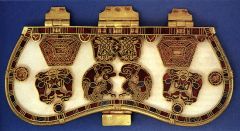
|
Sutton Hoo Purse Cover
period: Germanic date: 625 • found in Sutton Hoo ship burial, Suffolk, England • cloissone technique from Byzantium • interlace • animal forms • animistic = spirit of the universe |
|
|

|
Door Panels, Stave Church
part of Norwegian Stave Church period: Germanic date: 1050-1070 • interlace • animal forms • animistic • technically in Romanesque period but style is Germanic |
|
|

|
Chi Rho Iota Page, Book of Kells
period: Hiberno-Saxon date: 8th/9th century most likely from monastery in Iona, Scotland • Greek letters = first three letters of Christ’s name • use of interlace pattern • manuscripts may have served as meditative tool • clear relationship to earlier Germanic art but with Christian content |
|
|
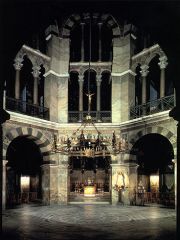
|
Palatine Chapel of Charlemagne
architect: Odo of Metz located: Aachen, Germany period: Carolingian date: 792-825 • desire to re-create the classical past • engineering skills lost; overbuilt • central plan church but octagonal, not round • three functions = mausoleum, chapel, martyrium housing holy relics • black & white pattern is borrowed from Islamic architecture |
|
|
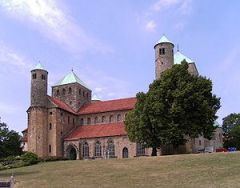
|
5) St. Michael’s Cathedral at Hildesheim
located: Hildesheim, Germany period: Ottonian date: 1001-1031 The builder, Bishop Bernward, also commissioned cast bronze doors for church Doors juxtapose Old and New Testament stories • Bernward studied classical monuments in Rome while guest of Pope in 1001 • church constructed between 1001 and 1031 • tower groupings and westwork • massive walls, few windows, dark interior show CD Rom #15 (last slide) • unusual double transept plan gives church eastern and western centers of gravity • nave seems like a mere hallway connecting the two transepts • unlike traditional basilica – has TWO apses, enter from north and sout in aisles • alternate support system = heavy piers at the corner of each square alternates with wall supports – this becomes a standard element in Romanesque churches |
|
|
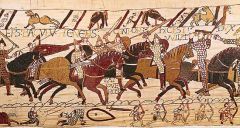
|
Bayeaux Tapestry
period: Romanesque date: 1070-1080 • commissioned by Bishop Odo, brother to William the Conqueror • propaganda for William the Conqueror • depicts Harold Godwinson as an oath breaker • shows details of medieval life • not technically a tapestry, but rather, an embroidery • one of the most complex narrative art works ever produced |
|
|
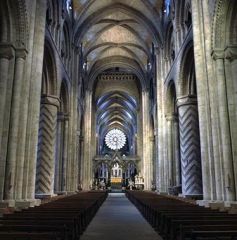
|
Durham Cathedral
period: Romanesque date: begun 1093 • first use of ribbed vaulting • built as part of Norman complex; style moves to Norman churches on continent • eclectic interior, with different designs on columns • once would have been brightly painted • still heavy piers, which makes it Romanesque despite the rib vaulting |
|
|
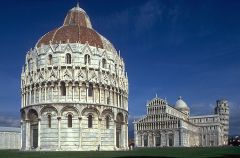
|
Pisa Cathedral Complex
location: Pisa, Italy period: Romanesque date: begun 1063 • complex includes 4 separate structures: cathedral, baptistery, campanile and mausoleum • typical arrangement in Italy, esp. Tuscany, to separate these buildings • use of black and white marble • Pisan victory of Muslims in 1062 led to building of cathedral complex |
|
|
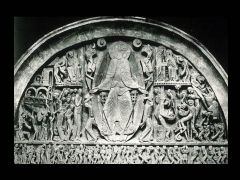
|
Tympanum, St. Lazare, Autun, France
location: Autun, France period: Romanesque date: 1120-1135 • shows Last Judgment, including souls being weighed and figures consigned to hell • a church on pilgrimage route – church militant • view of Christ as judge rather than Christ as savior |
|
|
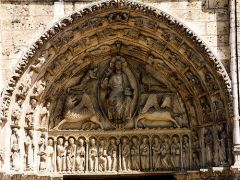
|
Royal Portal, Last Judgment Tympanum
location; Chartres, France period: Gothic date: 1145-1155 • shows Last Judgment with Christ in Majesty surrounded by symbols of 4 evangelists • view of Christ as savior • part of 3 part program including incarnation and resurrection |
|
|
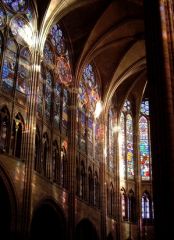
|
Abbey Church of Saint Denis, St. Denis, France
location: Chartres, France period: Gothic date: 1140-1144 (ambulatory, chapels, choir) • sparks the Gothic style, dating from June 11, 1144 when church was dedicated • airy interior creates “lux nova” – the new light • possible because of rib vaulting; columns no longer need to bear all of weight • use of lots of stained glass • opens up the apsidal chapels; open space inside ambulatory |
|
|
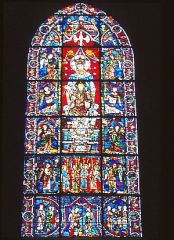
|
) Notre Dame de la Belle Verrier
location: Chartres, France period: Gothic date: 1170 • survived the fire of 1194 • exemplifies the Cult of the Virgin • shows Virgin Mary as Queen of Heaven with crown, throne • “little old man” Jesus on her lap • lux nova: uses light to transform the material world into the spiritual world |
|
|
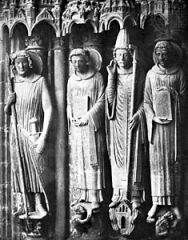
|
St. Theodore, South Portal, Chartres, France
location: Chartres, France period: Gothic date: 1230 • shows development of Gothic sculpture into more naturalistic style • contrapposto pose • contemporary clothing of Crusader • realistic expression |
|
|
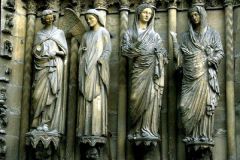
|
The Visitation, Reims Cathedral, Reims, France
location: Reims, France period: Gothic date: 1230 • Mary and St. Elizabeth, mother of John the Baptist • appear to be conversing • dressed as Roman matrons • realistic poses – gesturing toward each other, sinuous “S” curve |
|
|
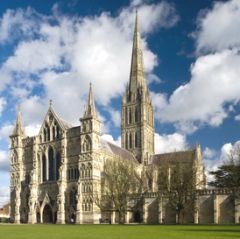
|
Salisbury Cathedral
location: Salisbury, England period: Gothic date: 1220-1258 • church has long nave and two transepts • complex incorporates monastic elements – cloister & chapter house • rood screen would separate monks from lay people • spire completed 100 years later and is highest part of cathedral |
|
|

|
Ekkehard & Uta
period: Gothic date: 1220-1258 • exemplify enhanced naturalism of high Gothic style • appear to be individualized portraits but actually completed long after the subjects died • secular subjects placed in a sacred setting location: Naumburg Cathedral, Naumburg, Germany |
|
|
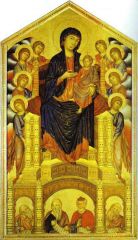
|
Madonna Enthroned
artist: Cimabue period: Early Renaissance date: 1280-1290 • shows maniera greca style (gold background, iconic image) • Gothic characteristics include iconic image of Mary enthroned; hierarchical scale of Virgin Mary vis-à-vis angels; little to no modeling of Virgin’s body • pre-Renaissance characteristics include some spatial depth; some expression in Virgin’s face; individuation of other figures |
|
|
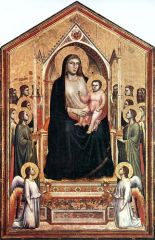
|
artist: Giotto
period: Early Renaissance date: 1310 Giotto’s Madonna has some features in common with Cimabue’s, indicating it is nearly Gothic: • seated on a throne • throne resembles a Gothic building – delicate, pointed gables • flat gold background of the maniera greca • use of hierarchical scale for the figure of the Virgin What makes it a Renaissance work: • Madonna has sculptural solidity and weight • bodies are modeled under draperies • balance and symmetry of composition • space seems 3 dimensional • relationship between Madonna and child more believable |
|
|
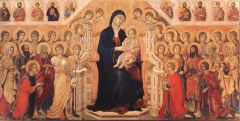
|

|
Maesta Altarpiece (front) + Betrayal of Jesus (back)
artist: Duccio period: Early Renaissance date: 1309-1311 • commissioned when Siena at height of power and wealth • polyptych, very large (13 feet high when intact) • front conforms to Gothic “Madonna Enthroned” style w/maniera greca • back more naturalistic: features betrayal of Jesus in the Garden of Gethsemane |
|
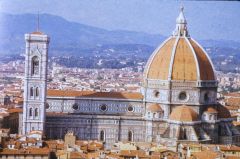
|
Florence Cathedral
architect: Arnolfo di Cambio period: Early Renaissance date: begun 1296 • designed to be very large to compete with other Italian city-states, esp. Siena • horizontal rather than vertical orientation • wide open interior • campanile designed by Giotto architect: Arnolfo di Cambio period: Early Renaissance date: begun 1296 |
|
|
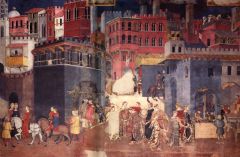
|
Allegory of Good Government in the City
artist: Ambrogio Lorenzetti period: Early Renaissance date: 1338-1339 • part of a fresco cycle decorating the Sala della Pace where the governing council meant • theme meant to inspire the council – what constitutes good gov’t • attempt at perspective and appropriate scale of figures to buildings • reasonable facsimile of Siena • involves allegorical figures |
|

